Abstract
Objective:
To compare the scholarly productivity index (SPI) among the levels of academic appointment, degree type, and percentage of academic appointment of athletic training faculty members.
Design and Setting:
We used a 5 × 6 × 4 factorial design for this study. A survey instrument was used to determine the number of publications and the number of years in their current appointment.
Subjects:
Subjects were faculty members in Commission on Accreditation of Allied Health Education Programs-accredited athletic training education programs.
Measurements:
The SPI was calculated by dividing the total number of publications (peer-reviewed and non–peer-reviewed journal articles, peer-reviewed abstracts, books written or edited, book chapters, platform presentations, published book reviews, and external funding) by the number of years in the productivity period.
Results:
The SPIs were different for the levels of academic rank. Full professors had a higher SPI than all other groups (Tukey honestly significant difference, P ≤ .05). Associate professors had higher SPIs than instructors or lecturers and clinical specialists, equivalent SPIs to assistant professors, and lower SPIs than full professors. Assistant professors had lower SPIs than full professors but were equivalent to all other groups. There were no differences among the levels of degree type or percentage of academic appointment.
Conclusions:
The scholarly productivity of athletic training educators was affected by their academic rank but not by the percentage of time they were assigned to academics or their academic degree type.
Keywords: scholarly productivity index, athletic training education, tenure, promotion
The evolution of a profession can be measured through the development of its educational process. A 1997 decision by the National Athletic Trainers' Association's (NATA) Board of Directors to implement a single route to certification, although a landmark in our professional development, has increased the emphasis on hiring and retaining full-time athletic training faculty. Although beneficial to the institution, the department, and the profession, appointment in a tenure-track position carries with it a set of demands that are unique to the world of academia. No other work environment offers a concept similar to tenure, a lifetime contract.
Although scholarship is essential for the individual faculty member, it is also vital to the advancement of the athletic training profession. Faculty members who are engaged in scholarship help to integrate athletic training into the mainstream of academia and communicate the tenets of our professional practice to other allied health and medical professionals. The manner in which our profession is judged will be based largely on our contribution to the knowledge base needed for athletic health care and the scientific validation of our professional practice.1,2
Many new athletic training scholars are faced with the difficult task of developing and maintaining their teaching, research, and service activities while implementing or administering (or both) a Commission on Accreditation of Allied Health Education Programs (CAAHEP)–accredited athletic training program, often before or immediately after completing their doctoral programs.3,4
The decision to grant tenure is generally based on an individual's achievement in the areas of teaching, scholarship, and service. Although objective standards in the form of course evaluation instruments have been developed to measure an instructor's effectiveness and service contributions are often contract based, the determination of a candidate's relative scholarly accomplishments is more esoteric. Ultimately, the decision to grant tenure is heavily weighted toward the number of refereed publications and the individual's ability to obtain external funding through grant acquisition.5–8 A scholarly productivity index (SPI) has been developed as a mechanism to objectively measure scholarly output.2,5
Athletic training educators possess different types of degrees, have appointments with varying percentages of time dedicated to academics, and hold various academic ranks. The extent to which these factors influence scholarly output has not been identified. Information about scholarly productivity by peers would be valuable in assisting athletic training scholars and their supervisors to develop reasonable expectations about scholarly output given the diverse responsibilities usually undertaken. Adjustments in responsibilities could then be considered to provide the athletic training faculty member with the appropriate time to meet institutional expectations for scholarly activities. The purpose of our study was to compare scholarly productivity of athletic training faculty within NATA-approved and CAAHEP-accredited athletic training programs by degree type, percentage of academic appointment, and academic rank.
METHODS
This study used a 5 × 6 × 4 factorial design. The dependent variable was the SPI. Independent variables were academic appointment (instructor or lecturer, clinical specialist, assistant professor, associate professor, and full professor), degree type (BS, MS, MA, MEd, PhD, EdD, and other), and percentage of academic appointment (0% to 25%, 26% to 50%, 51% to 75%, 76% to 100%).
Subjects
The names and addresses of 94 undergraduate and 12 graduate directors of NATA-approved or CAAHEP-accredited entry-level programs and NATA-accredited graduate athletic training programs were obtained from the NATA World Wide Web site (www.nata.org). The program director and any faculty member returning the survey instrument served as subjects. All subjects were faculty members in CAAHEP-accredited entry-level or NATA-approved postcertification graduate athletic training education programs. Six institutions had both undergraduate and graduate programs. In those cases, individuals were represented only once in the data set. Sixty-eight (68%) of the 100 institutions responded to the survey, yielding a total of 200 faculty responses.
Survey Instrument
The data collection instrument was based on the similar studies investigating the scholarly productivity of occupational therapy and physical therapy faculty.2,5 Demographic information regarding the respondent's highest degree, the year this degree was earned, the year the academic appointment was received, and the current academic rank and tenure status was collected for grouping purposes. The time between the date the survey was received and the most recent date since the respondent's highest degree was earned or the current academic appointment was granted was identified as being the “productivity period.” For instance, a person who was employed by the institution in 1990 and received a doctorate in 1995 would have 3 productivity years, as we conducted the survey in 1998.
The remainder of the instrument ascertained the number of scholarly endeavors accomplished during the productivity period. Respondents were asked to identify the number of articles accepted for publication in peer-reviewed and non–peer-reviewed journals, abstracts in peer-reviewed journals, books written or edited, book chapters, platform presentations at district or national athletic training or sports medicine conferences, published book reviews, and the number and dollar amount of external grants awarded. Each institution was assigned a unique code number for matching returns and monitoring return rates.
To determine the instrument's face validity, athletic training and other allied health faculty members pilot tested the survey. Comments were collected, and the appropriate changes were made. The final data collection instruments and methods were approved by the Northeastern University Institutional Review Board.
Procedures
The program director was mailed copies of the survey instrument, cover letter, and institutional review board statement, along with a self-addressed, stamped return envelope. The recipient was asked to distribute the instrument to each certified athletic trainer who held a full or partial academic appointment with the program. Completed surveys were to be returned by November 15, 1998. An e-mail was sent as a follow-up to individuals who had not returned their survey by November 25, 1998.
Statistical Procedures
The SPI was calculated by dividing the total number of publications (peer-reviewed journal articles, non–peer-reviewed articles, published abstracts, textbooks and textbook chapters authored or coauthored, and professional presentations) by the number of years in the productivity period. We used a 3-way analysis of variance to detect differences in SPI among the levels of academic appointment, degree type, and percentage of academic appointment. The Tukey honestly significant difference test was used for post hoc comparisons. A probability level of P < .05 was used for all tests. The Statistical Package for the Social Sciences for Windows (version 9.0, SPSS Inc, Chicago, IL) was used to perform all statistical tests.
RESULTS
Sixty-eight of the 100 institutions surveyed responded, yielding a 68.0% return rate. Demographic information on the responding faculty and program directors is presented in Tables 1 through 3. The SPIs were different for the levels of academic appointment (F4,121 = 2.4, P = .05) (Table 4). Full professors had a higher SPI than all other groups (Tukey honestly significant difference, P ≤ .05). Associate professors had higher SPIs than instructors or lecturers and clinical specialists, equivalent SPIs to assistant professors, and lower SPIs than full professors. Assistant professors had lower SPIs than full professors but were equivalent to all other groups.
Table 1.
Subject Demographics by Academic Rank
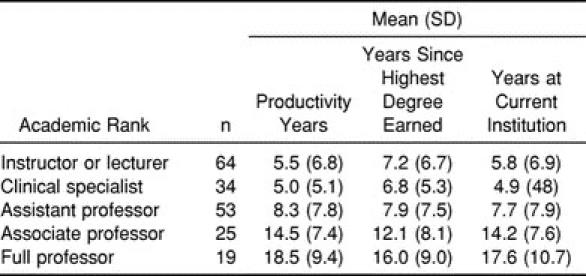
Table 3.
Subject Demographics by Degree Type
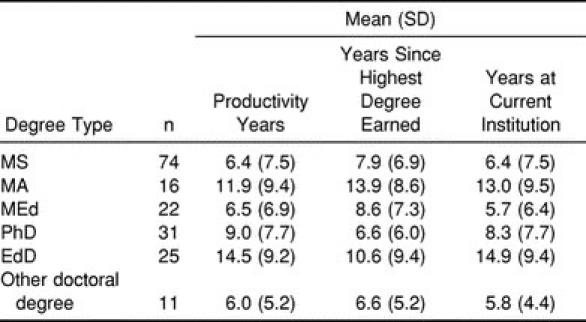
Table 4.
Scholarly Productivity Index by Academic Ranks
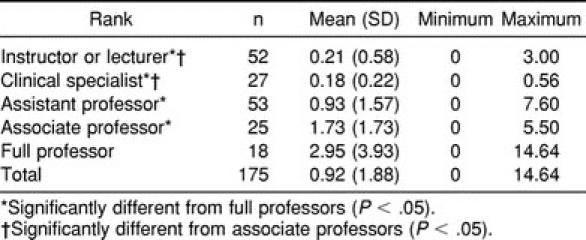
Table 2.
Subject Demographics by Percentage of Academic Appointment
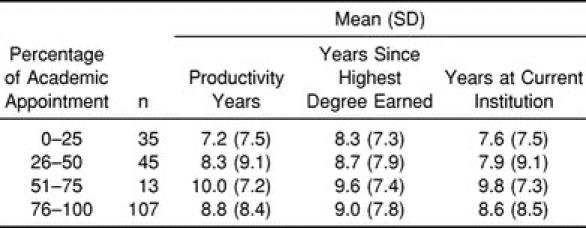
We found no statistical differences among the levels of degree type (F5,121 = 2.0, P = .08) (Table 5) or percentage of academic appointment (F3,121 = 0.26, P = .85) (Table 6). Table 7 presents the rate of various publications by academic rank.
Table 5.
Scholarly Productivity Index by Degree Type
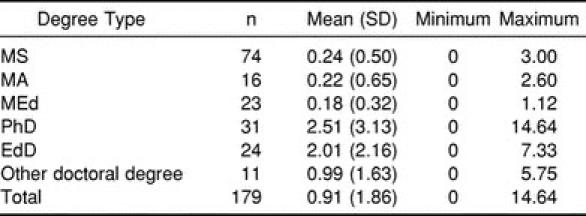
Table 6.
Scholarly Productivity Index by Percentage of Academic Appointment
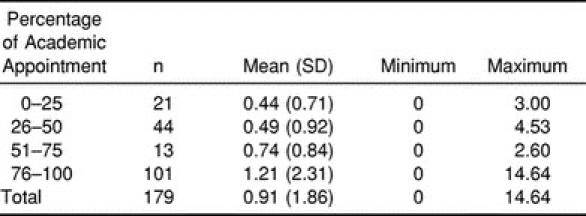
Table 7.
Scholarly Productivity Index Elements of Scholarship by Academic Appointment
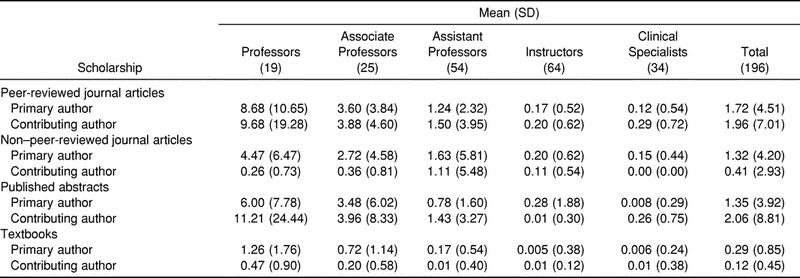
DISCUSSION
The concept of program directors' obtaining tenured status was first discussed in our professional journal by Perrin and Lephart in 1987.9 At that time, the authors recognized the conflicts between the criteria required to gain tenure (teaching, scholarship, and service) versus the clinical demands or the rigors of implementing a new academic program that are placed on many program directors. This conflict will become more problematic as program directors are appointed to full-time, tenure-track faculty status.
Several institutional and personal factors influence the scholarly productivity of individual faculty members. Institutional variables include the type of institution,6 its organizational structure,10 institutional support,7 and the leadership style of the department chairperson.11 Individual variables that affect scholarly productivity include career motivation,8 academic degree,6 tenure-track status,6 sex,6,7 and family obligations.7
The large SDs for SPI based on the type of academic degree and percentage of academic appointment indicate that some individuals were very productive. Other faculty members had zero productivity. The high SDs in both of these areas could have masked true statistical differences in these variables (ie, resulted in low statistical power). Although we did not detect different SPIs associated with academic degree or percentage of academic appointment, institutions typically have different tenure and promotion standards for these groups.
We were at first surprised that the percentage of academic or athletic department appointment had no influence on the SPI. However, when examining the scholarly productivity of physicians in schools of family practice medicine, Katerndahl12 found that patient care and scholarly productivity were not dichotomous entities.
Other studies have demonstrated that institutions with graduate degree programs in athletic training tend to produce the bulk of our professional scholarship, and, overall, 15 institutions accounted for more than 42% of the scholarly activity in the Journal of Athletic Training.13 Indeed, a review of the authors published in the Journal of Athletic Training indicates that the bulk of scholarly productivity has come from lead authors who were nonacademicians, graduate students, or both. This contribution to our professional body of knowledge should be viewed as a positive attribute, since it serves to further validate our professional practice and skills.
Our data may have been skewed by the influx of new program directors who have recently received or who are currently completing their terminal degrees and who are also responsible for developing accredited programs.4 New program directors should attempt to negotiate recognition for gaining initial accreditation into their promotion and tenure portfolio and ensure that this effort receives appropriate weighting in the scholarship and service categories. Similarly, athletic training program directors or teaching faculty who have dual appointments but are on the tenure track should ensure that they will be well positioned for their tenure and promotion review. The proportion of time dedicated to the academic and clinical aspects should be weighted accordingly. The individual faculty member must have an appropriate amount of time built into the workload as a portion of the service component and an appropriate amount of time allocated for scholarship.
The granting of tenure is ultimately an institutional fiscal decision. A tenure award reflects the long-term allocation or reallocation of the institution's financial resources.14 Positive tenure and promotion decisions also indicate institutional support and recognition for the athletic training education program. For most athletic training educators to gain positive promotion and tenure reviews, the expectation is that a high level of scholarship will be maintained. Academicians who have a greater proportion of their workload dedicated to scholarship should be producing research at a higher rate than those who do not.
CONCLUSIONS
We found that full professors had a higher SPI than all other groups. Associate professors had higher SPIs than instructors or lecturers and clinical specialists but not full or assistant professors. Assistant professors had lower SPIs than full professors but were equivalent to all other groups. There was no statistical difference between the type of degree or percentage of academic appointment for the scholarly productivity rate of our respondents.
Historically, many athletic training program directors were primarily employed by the institution's athletic department, shielding them from the tenure process. As athletic training faculty members are integrated into the mainstream of academia, we must be prepared to meet the rigors of the tenure process and be held to the same standards of other allied health faculty members.
Certainly we need the clinical research and scholarship generated by nondoctorally prepared athletic trainers. However, we should begin to expect that the demands of the tenure process manifest as an increased rate of productivity by tenure-track faculty relative to those faculty who are not on the tenure track.
The lack of difference in SPI based on the percentage of academic appointment or type of academic degree does not suggest all should be considered equally in the tenure and promotion process. Institutions do differentiate individuals on these factors through internal policies and procedures. As the role of the athletic trainer educator continues to evolve, we must also see improved scholarly productivity from our faculty members. In the future, our scholarly productivity should improve so that we are able to identify differences associated with the type of academic degree and percentage of academic appointment.
REFERENCES
- 1.Wakefield-Fisher M. The relationship between professionalization of nursing faculty, leadership styles of deans, and faculty scholarly productivity. J Prof Nurs. 1987;3:155–164. doi: 10.1016/s8755-7223(87)80061-3. [DOI] [PubMed] [Google Scholar]
- 2.Holcomb JD, Christiansen CH, Roush RE. The scholarly productivity of occupational therapy faculty members: results of a regional study. Am J Occup Ther. 1989;43:37–43. doi: 10.5014/ajot.43.1.37. [DOI] [PubMed] [Google Scholar]
- 3.Fuller DV, Dewald LL. Job responsibilities among athletic training educators in NATA/CAAHEP accredited athletic training educational programs. J Athl Train. 2000;35:S42. [Google Scholar]
- 4.Walsh KM, Dewald LL. Tenure-track program directors—can you have it all? J Athl Train. 2000;35:S42. [Google Scholar]
- 5.Holcomb JD, Selker LG, Roush RE. Scholarly productivity: a regional study of physical therapy faculty in schools of allied health. Phys Ther. 1990;70:118–124. doi: 10.1093/ptj/70.2.118. [DOI] [PubMed] [Google Scholar]
- 6.Zyzanski SJ, Williams RL, Flocke SA, Acheson LS, Kelly RB. Academic achievement of successful candidates for tenure and promotion to associate professor. Fam Med. 1996;28:358–363. [PubMed] [Google Scholar]
- 7.Barhyte DY, Redman BK. Factors related to graduate nursing faculty scholarly productivity. Nurs Res. 1993;42:179–183. [PubMed] [Google Scholar]
- 8.Barnett RC, Carr P, Boisnier AD, et al. Relationships of gender and career motivation to medical faculty members' production of academic publications. Acad Med. 1998;73:180–186. doi: 10.1097/00001888-199802000-00017. [DOI] [PubMed] [Google Scholar]
- 9.Perrin DH, Lephart SM. Role of the NATA curriculum director as clinician and educator. Athl Train. 1987;22:301–303. [Google Scholar]
- 10.Kohlenberg EM. Faculty research productivity and organizational structure in schools of nursing. J Prof Nurs. 1992;8:271–275. doi: 10.1016/8755-7223(92)90052-z. [DOI] [PubMed] [Google Scholar]
- 11.Womack RB. Measuring the leadership styles and scholarly productivity of nursing department chairpersons. J Prof Nurs. 1996;12:133–140. doi: 10.1016/s8755-7223(96)80036-6. [DOI] [PubMed] [Google Scholar]
- 12.Katerndahl DA. Associations between departmental features and departmental scholarly activity. Fam Med. 1996;28:119–127. [PubMed] [Google Scholar]
- 13.Voll CA, Pitney WA, Storsved JR, Pitney LV. A five-year (1995–1999) analysis of scholarly activity among institutions publishing in the Journal of Athletic Training and supplement to the Journal of Athletic Training. J Athl Train. 2000;35:S42. [Google Scholar]
- 14.Nieman LZ, Donoghue GD, Ross LL, Morahan P. Implementing a comprehensive approach to managing faculty roles, rewards, and development in an era of change. Acad Med. 1997;72:496–504. doi: 10.1097/00001888-199706000-00012. [DOI] [PubMed] [Google Scholar]


